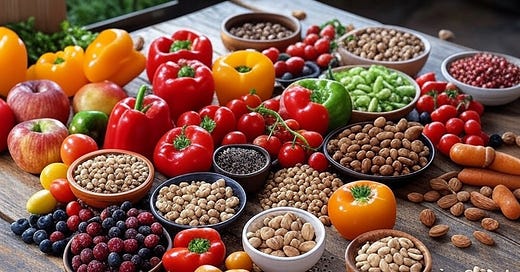Research: Nutrient-Dense Foods vs. Empty Calories: A Win for Health and the Food System
Nutrient-Dense Foods Satisfy with Fewer Calories
Introduction
Our bodies need a variety of nutrients – protein, vitamins, minerals – not just raw calories. Nutrient-dense foods (like vegetables, fruits, legumes, lean proteins) pack a lot of these nutrients per calorie. This means people can meet their biological needs while eating fewer total calories. In fact, because people tend to eat a consistent weight of food each day, choosing foods with high nutrients and low “energy density” lets us feel full on less energy (Calorie Density Approach to Nutrition and Weight Management). For example, one pat of butter has almost the same calories as two cups of broccoli, which shows how nutrient-rich foods deliver more fullness with far fewer calories ( Weight loss: Feel full on fewer calories - Mayo Clinic ). When our diet is rich in nutrients, the body doesn’t keep searching for missing vitamins or protein by overeating. Studies propose that if the protein or nutrient content of the diet is too low, people will compensate by eating more until those needs are met ( Did the food environment cause the obesity epidemic? - PMC ). A diet of mostly empty, cheap calories fails to satisfy these needs, leading to constant hunger signals. By contrast, nutrient-dense meals naturally curb appetite because the body gets what it requires. The result is that people can maintain a healthy weight without going hungry – more nutrition for fewer calories.
There’s also a powerful efficiency gain for the food supply chain: if each person requires fewer calories to be satisfied, we don’t need to grow, ship, and store as much total food mass. Globally, we already produce more than enough calories – about 2,720 per person per day on average – which is above the requirements for a healthy life (What are the differences in global calorie intake and food supply? - Internet Geography). Much of this excess ends up either wasted or waistline. Researchers even coined the term “metabolic food waste” to describe the extra food consumed beyond what the body needs. They estimate about 140.7 million tons of food each year is essentially wasted worldwide by being eaten in excess and leading to overweight (Frontiers | Metabolic Food Waste and Ecological Impact of Obesity in FAO World's Region). In North America alone, over 32 million tons of food per year end up as excess body fat (Frontiers | Metabolic Food Waste and Ecological Impact of Obesity in FAO World's Region). Imagine the savings if we cut that unnecessary production. A nutrient-dense food system could meet nutritional needs with less total food by weight. Fewer truckloads of low-value filler and sugary products would be needed, streamlining the supply chain. In short, nutrient-dense eating means meeting human needs with less food, which can lighten the load (literally) on agriculture and logistics.
Keep reading with a 7-day free trial
Subscribe to Food is Health to keep reading this post and get 7 days of free access to the full post archives.




